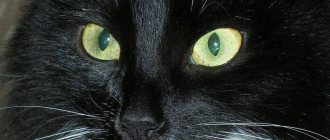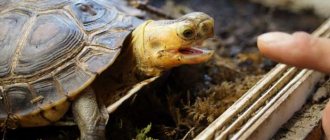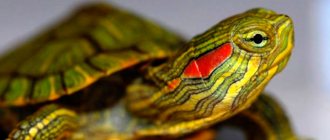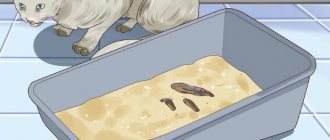Nutrition
Only from this can we already draw some conclusions. A turtle's diet at home should contain the type of food that is closest to natural. In our part of the world these are weeds. For example, these:
- Dandelion (leaves and flowers)
- Nettle (young)
- Plantain
- Clover (leaves and flowers)
- Thistle
- Snooze
- Burdock
- Bird's knotweed
- Yarrow
- Sagebrush
- Hay (source of coarse fiber)
These herbs are very popular; in fact, they are weeds. In spring and summer they can be found almost everywhere, but they need to be collected in places more distant from roads. Before giving food to the turtle, do not forget to rinse it under water (at the same time the plant will absorb moisture). As you can see, in terms of diet, everything is very simple, and, most importantly, it’s free.
What to do in winter?
During the cold season, herbs must first be frozen or dried. Just put the required amount of preparations in a bag and in the freezer. Alternatively, lay the greens on a flat surface (table, windowsill, cabinet, etc.) and let them dry naturally. Do not dry the grass in direct sunlight, only in calm shade, so the plants will retain maximum benefits. Dried food can be kept in a bag in a dark, dry place.
You can also buy dry herbs at the pharmacy (calendula marigold, dandelion, sage, plantain), they can be added to food mixtures. In winter, you can grate carrots and add dry grass to it. Making such a paste is not difficult, and there are definitely benefits from it.
Read more about harvesting herbs for the winter
It is strictly forbidden to give any human food: meat, fish, milk, bread, eggs or food of other domestic animals. Such products are extremely harmful to turtles. Their consumption affects the stomach and kidneys, which subsequently causes destructive diseases. It is also not recommended to give fruit. They are also not designed for the gastrointestinal tract of the Central Asian turtle, cause fermentation and are poorly digestible. In addition, you should not give cabbage and other foods that contain a lot of phosphorus; it removes calcium from the turtle’s body.
Conclusions: the turtle should be fed with herbs (95% of the diet), and very rarely given vegetables (for example, carrots, they contain vitamin A). It is forbidden to give products not designed for this type of animal.
Read more about the nutrition of the Central Asian turtle Roxy
Selecting a sealant
Glue plays the main role, because it is thanks to it that the entire structure is fixed and further retained. There are many types of substances that can be used to connect pieces of glass to each other. But with regard to aquarium glue, the following requirements are put forward:
- non-toxic;
- high strength;
- elasticity;
- presentable appearance;
- relatively fast setting;
- ease of application;
- long service life;
- high degree of adhesion.
Sealant for aquariums
Silicone sealant has all these properties
But when purchasing, you should pay attention to the fact that it is 100%, without impurities and not antibacterial, otherwise the living creatures will simply die. Today there are three main colors available: white, transparent, black. If you use the first one, the aquarium will have the appearance of a certain incompleteness
The second is well suited for products up to 100 liters. Anything more is best glued with black. Small structures with it look very bulky, but in large ones, on the contrary, it emphasizes the lines and gives elegance. The choice of those who have been assembling aquariums for some time often falls on Dow Corning 911, KNAUF 881 or Kleiberit Suprasil 590E
If you use the first one, the aquarium will have the appearance of a certain incompleteness. The second is well suited for products up to 100 liters. Anything more is best glued with black. Small structures with it look very bulky, but in large ones, on the contrary, it emphasizes the lines and gives elegance. The choice of those who have been assembling aquariums for some time often falls on Dow Corning 911, KNAUF 881 or Kleiberit Suprasil 590E.
Lid
A similar detail may be needed if you have other animals living in your house that could harm the turtle. In this case, the lid on the terrarium will protect your pet from danger.
The lid can be made from absolutely any materials. However, when choosing a suitable option, pay attention to the fact that under the cover there will be an electric lamp designed to illuminate the terrarium. Therefore, it is better for you to give preference to fire-resistant materials, such as glass or some kind of metal. When attaching the lamp, make sure that it does not touch the walls and lid of the terrarium structure.
Conditions for keeping the red-eared turtle
The red-eared turtle critically needs only water and a beach with recommended temperature parameters, and a balanced diet. For the proper development of the skeleton and shell, the animal needs calcium. Vitamin D3 is required for calcium absorption.
Sources of vitamins for the predatory red-eared turtle - food and ultraviolet light (for D3)
Therefore, it is important to imitate natural food diversity and sunlight. The turtle is omnivorous. Under the age of 2–3 they prefer meat foods
After puberty (4 years), 30–50% of the diet consists of plant food
At the age of 2-3 they prefer meat food. After puberty (4 years), 30–50% of the diet consists of plant food.
- Meat, except pork and lamb (excessively fatty). Heart, liver weekly (vitamin A). Under natural conditions they successfully hunt rodents and birds.
- Grasshoppers, locusts, cockroaches without legs (the legs have spines). Earthworms, land snails.
- Aquarium snails are useful. Chewing on shells limits unwanted beak growth.
- Sea fish (river fish is dangerous with parasites) with small bones. Do not remove the entrails; they contain vitamin A. Fatty species (capelin, mackerel) are pre-soaked. Crab meat, mussels, unpeeled shrimp. Aquarium animals of suitable sizes.
- Aquarium plants, except Elodea. Indoor plants: cacti and agave with spines removed, tradescantia, hibiscus, tradescantia.
- Non-poisonous herbs, beet and carrot tops, nettles. Dried for the winter.
- Oatmeal (Hercules). Vegetables, fruits, berries. Sunflower seeds, pumpkin seeds.
If your red-eared slider is chewing on a cuttlefish bone placed in a jar (sepia, sold in pet stores), there is not enough calcium in the diet. Adjust the menu in favor of small fish and insects. Add limestone stone to the soil. Add calcium gluconate (available in pharmacies) to your food. Check if the UV light is sufficient. Pet stores offer mineral and vitamin supplements for turtles. Lack of calcium causes rickets in animals.
Feed turtles up to one year old once a day. Gradually reduce the frequency of feeding by introducing a weekly fasting day. Three-year-old individuals need to eat 2-3 times a week.
Caring for your pet consists of cleaning algae from the shell and trimming its claws. The shell is part of a living organism, it is renewed, sensitive, and has nerve endings. Hard brushes, especially chemicals, are unacceptable for cleaning. Patience and a soft sponge will help
Trim the nails carefully, do not damage the blood vessels. Do not use regular scissors. There is a special tool in stores
There is a special tool in stores.
Which aquaterrarium is suitable?
The main criterion when choosing is safety. The beauty of the aquaterrarium should be secondary. Otherwise, you risk purchasing a toxic product that will poison your pet’s health.
The second criterion is suitable size. Based on how tall your turtle breed will grow. As a rule, the “height” of males is up to 17 cm, females – up to 20-21 cm. The reptile should feel free inside and move around without the feeling of limited space. As for the volume of the aquarium, this is at least 100, and preferably 150-200 liters for one individual, and 250 for two. If you take a smaller volume, the water will become polluted faster, and this is fraught with the development of diseases in turtles. The water level in the aquaterrarium should be at least 40 cm in order to change it less often.
If you take a young turtle, it is permissible to plant it in a small aquarium and then replace it with a larger one.
The aquaterrarium must have a lid, otherwise the turtle may decide to go on a journey. But the reptile will not last long without water, so provide a lid to prevent escape and possible death of the pet. If your aquaterrarium does not have a lid, then there should be at least 15-20 cm of reserve above the water level.
"...lonely, like an island in the ocean." Rules for building sushi
If you are setting up a beach for a turtle with your own hands, then the ideal ratio of land and water is 1:4. That is, land should occupy 25% of the area of the aquaterraria. This is provided that the shore or island is no less than 4 turtle sizes. If a whole flock of agile turtles lives in an aquaterrarium, then the land area should be several times greater than the total size of all the turtles.
1. Access to land, that is, a ladder or ascent, should be as convenient and safe as possible. Excessively steep inclines and sliding surfaces should be avoided. The ladder must have a corrugated and rough surface. The angle of elevation should be as obtuse as possible. It will be good if you build an island for the red-eared turtle with your own hands with an angle within 160°.
2. The shore should rise above the water surface by at least 25-50 (mm).
3. The land must be warmed up and exposed to ultraviolet radiation. You can read about how to properly organize lighting and heating of the shore in this section.
DIY shore for an aquatic turtle
How to build land?
A shore can be created:
- Based on suspended structure
- With support on the bottom of the reservoir
Suspended structures have a more practical and aesthetic design. That is, a do-it-yourself hanging island for a turtle is a neat and sophisticated island that is created for the pet’s maximum comfort.
The shore supported by the bottom is more massive. Such designs look very natural and natural. Islands supported on the bottom are most often presented in the form of a large stone sculpture, which is simply immersed in a body of water, so that it looks out of the water by 25-50 (mm) and has at least one flat side along which the turtle will climb onto the island .
DIY turtle island
1. If you are creating a suspended bank for a turtle with your own hands, then you can use the following as building material:
- Ordinary glass with rounded edges
- Tile without sharp edges
Why these materials? – The fact is that glass and tiles are completely hypoallergenic materials that do not change the chemical and structural composition of water. If you take plastic or wood impregnated with a water-repellent solution, then the water in the aquaterrarium will slowly but surely be poisoned by all kinds of toxins.
2. If you are building an island for a red-eared turtle with your own hands with support on the bottom, then you can use the following material as material:
- Large pebbles. These are large rounded blocks. You can take not just one pebble, but 3, 4 or all 5
- Solid natural stone
- Granite statue
- corral reef
The advantage of these materials is their natural and natural texture. Stone blocks do not need to be processed or otherwise brought to perfection. The disadvantage of these materials is their massiveness. That is, if the suspended islands do not occupy the space of the reservoir. then the land resting on the bottom of the reservoir takes away precious water space.
Building an island in an aquaterrarium for a turtle
Place for an aviary
Proper placement of the terrarium will improve the comfort of your “ward” and increase its lifespan. The enclosure is never placed in drafts, in places where there is a flow of people, in dirty places, on the floor, or in direct sunlight. It is important to think through the turtle’s home and territory in such a way that it has a choice - to go for a walk in the enclosure or quietly hide from prying eyes. A DIY land turtle terrarium can last for several years if kept clean.
If you found the article “Terrarium for a land turtle with your own hands” useful, then add the article to bookmarks, share with friends and on social networks
How to make a turtle house with your own hands
If you want to make a temporary or permanent habitat for a turtle, it’s not a problem at all
It is important to have the skill to work with tools and the desire to create a beautiful and cozy house for a reptile. We offer you two options - temporary from cardboard or permanent from moisture-resistant plywood
Temporary housing
If you have not had time to prepare for the appearance of a turtle in your home, then take a large box made of thick cardboard (the height of the walls should be at least 30 centimeters). Using a clothespin or other device, attach a lamp with a 30 W bulb to the box or place a table lamp nearby.
You can put an isolon mat or several layers of warm coating on the bottom. The finished house, temporary housing for the turtle, should be placed higher - drafts and hypothermia are possible on the floor.
Plywood terrarium
To create a high-quality house for a turtle from moisture-resistant plywood, make a clear and competent sketch. We recommend focusing on a box whose height is 25-30 centimeters. In this case, the optimal width and length parameters will be 80x50 cm. Prepare five parts:
- The bottom is 80x50 centimeters - one piece.
- The back and front walls are 80x25 centimeters - one piece is made of glass and one of plywood.
- Side walls 43x25 centimeters - two pieces.
All workpieces must have machined, smooth edges. Place the lower part of the terrarium (bottom) on the work surface (table). We carefully glue the side walls to it with universal glue. The next step is to add the last wooden piece to the structure and fix it with glue. At this point, you should definitely check the reliability of the connection. Instead of universal glue, you can use liquid nail sealant or self-tapping screws.
In order for the structure to last for a long time, it must be fixed with corners and screws. To prevent the reptile from being injured by protruding metal parts, they must be decorated.
Having assembled and secured the three parts of the homemade terrarium, we supplement the glue box with a glass panel.
After completing the assembly of the product, it must be checked for any cracks or holes. A day later, when the glue has dried, you can begin sealing the connections - use aquarium silicone glue. If this is not done, dirt will get into the cracks and the structure will not last long.
You need to attach legs to your homemade terrarium. They can be made from scrap materials - screws and bottle caps. To prevent the plywood from moving, install five legs.
Now you can decorate your home with lamps, flooring and a lid - the home for the land turtle is ready!
Terrarium made of glass or plastic
To work with glass, you first need to additionally prepare the material - cut it according to the drawing into the necessary parts in the workshop or yourself using a glass cutter. The edges of the parts must be smoothed and sanded with sandpaper. Plastic can be cut evenly with a construction knife, a thin hacksaw, or a heated blade. Then the following steps are performed:
- The bottom of the future terrarium is laid on a flat surface, a part of the side wall is placed next to it and the joint is taped with masking tape, then the wall rises up.
- In the same way, attach the remaining walls and assemble the frame of the product - all the tape must be inside, the finished frame is turned upside down, and the parallelism of the walls is checked.
- The joints on the outside are degreased and coated with glue-sealant (it is recommended to choose a simple silicone-based composition; specialized products designed for working with aquariums are suitable).
- The glue is leveled, the excess is carefully removed, then the final second layer is applied.
- The terrarium is left to dry for several hours, then it is turned over, freed from the tape and the joints are coated from the inside.
- The finished product should dry for 2-3 days.
To increase the stability of a large terrarium, you can fasten it from the outside with plastic corners. It is better to cover a glass aquarium with a mesh on top so that the turtle has a flow of fresh air; a plastic one can be made closed and carefully drill holes for ventilation in the side walls.
If necessary, a shelf made of plastic or glass is attached to the inner surface of the walls - it is better to make a support under it so that the shelf does not break under the weight of the turtle. To make it comfortable for your pet to climb upstairs, a ladder with a textured surface is glued on.
Filling the terrarium
In order for the turtle to feel good, not get sick and make all family members happy, it is necessary to create favorable living conditions for it. Let's decide how to fill the terrarium correctly.
The lid will protect the reptile from attacks by other inhabitants of the apartment - for example, cats. In addition, it is on the cover that you will mount the lamp, so the material for this part must be chosen carefully. Most often it is glass or metal.
If the conversation turns to lighting, then we can recommend a regular 60 W light bulb. It must be placed in such a way that it does not touch the walls, without creating overheating and a fire hazard. The corner that the lamp heats will be used by the turtle for eating, bathing and resting. The temperature in this place should not exceed 30°C, and in the rest of the terrarium - within 23-26°C. In the coldest and most shaded place, it is worth installing one or more shelters - a purchased or home-made house, a hollow driftwood, part of a clay pot, half a coconut.
It is worth installing an ultraviolet lamp. Keep in mind that the distance from the floor surface to the lighting fixtures must be at least 30 centimeters so that the turtle does not get burned.
One ventilation hole should be located at the top, for example on the side wall. You can make another one near the floor on the opposite wall. This will ensure the necessary flow of oxygen, stable air exchange, and elimination of unpleasant odors.
The soil is poured in a high layer, 3-5 centimeters. Small particles cannot be used as a coating - the reptile can swallow them. So put away sand, gravel chips, and small substrates. Sharp objects are also dangerous: expanded clay, gravel, shavings. Land turtles feel good in terrariums where the floor is covered with large sawdust, hay, and round pebbles. If the turtle does not like to burrow into the ground, then you can put paper or napkins.
Climate
Like other reptiles, turtles cannot regulate their body temperature on their own, so it is important to create two temperature zones. In one the temperature should be about +30 °C, in the other - +25 °C. The easiest way to do this is by directing the light from the lamp: set it so that the warm zone is “in focus” and the cool zone is not. In the cold part of the terrarium you need to place a container with low sides for water. It will serve as a swimming pool for the turtle, a drinking bowl, and at the same time maintain sufficient air humidity.
Size and materials
The classic terrarium for a land turtle is a square or rectangular box made of glass, plastic, wood or plastiglas.
A DIY terrarium for a land turtle does not have to be made entirely of glass. Like any living creature, domestic reptiles want to hide from daylight or their own owner. Therefore, use ready-made terrarium designs, where glass is combined with plywood, and you can also use plexiglass or impact-resistant plastic to create a convenient design.
To make your pet’s home easier to clean, we recommend making one of the walls removable – with magnets or grooves. To prevent the turtle from getting out of the terrarium during cleaning, it is necessary to consider sides 20 centimeters high. What should be the area of the house itself? The calculation must be made based on the number of turtles and their size. For one land turtle that will not grow more than 15 centimeters, you can build a box with a minimum area of 0.5 square meters. m. Most often the sizes chosen are 60x40x50. You should not focus on the size of a young reptile - it will grow very quickly and may be uncomfortable in a small space.
How can I replace a terrarium for a turtle?
Many owners of land turtles want to make a house for them with their own hands. To do this, they improve ready-made designs and often this decision justifies itself. Here are some examples of where you can start creating a home terrarium:
- You can separate a small area of the room for the turtle to live there. It is worth considering the location of this pen - in a corner, away from batteries and carefully protected from drafts. It is worth considering that the temperature in the room should be regular, within 26-28°C, and you will have to take care of an additional lighting system. On the indoor flooring you need to put an unnecessary piece of laminate or wallpaper, pour gravel, sawdust or hay. Don't forget to protect the turtle with a low fence so that it cannot run away and hide.
- Instead of a terrarium, you can place your family favorite in an old unnecessary aquarium with a flat bottom. It is advisable that it be accompanied by a cover with the ability to place a UV lamp, as well as ventilation holes.
- A large plastic container can become a temporary home for a land pet. You will also need to consider a heating and lighting system to prevent the turtle from getting sick.
- An ordinary wooden box is a great solution, but it will have to be improved a little. First, you will have to remove one of the walls, replacing it with a transparent panel. Second, drill some holes.
Design options
On the Internet you can find drawings of products of various shapes, but their design cannot always be repeated at home. For self-production, simple options are suitable - horizontal rectangular containers with low walls. The area of the terrarium is preliminarily calculated, which should be 5-6 times larger than the size of the turtle itself. So for a pet with a shell diameter of 10-15 cm, the minimum terrarium size is 60x50x50cm. If several individuals are kept together, the area must be increased accordingly.
It is better to take into account in advance that the turtle will grow over time, as well as the ground level of several centimeters. It is also not recommended to make walls that are too high - in high containers the air flow is worse and moisture accumulates.
If the conditions in the apartment allow it, it is recommended to build a large floor-mounted terrarium-enclosure with an area of several square meters. In nature, land turtles love to explore their surroundings and travel long distances, so they feel more comfortable in a large dwelling.
If there is not enough space, on the contrary, you can build a terrarium for your pet on a closet shelf - for this you will have to install a plastic or glass tray there.
If the house used to have fish, from which the equipment remains, you can make a terrarium from an aquarium.
DIY wooden terrarium for a land turtle
This is the most common option for arranging a home for a turtle, due to the unpretentious design, quality, reliability and strength of the wooden box. And, most importantly, it will be a more natural habitat for the pet. At the same time, you can calmly think through options for placing lamps for heating the turtle. You can even adapt a lifting and wide shelf, along which it will be convenient for the turtle to climb, like a ladder. And underneath you can arrange a pool for the turtle (she will be very grateful for this).
Simple technology for arranging a wooden enclosure
- A plywood sheet is taken and the base is cut out (about 90×50 m).
- Using glue, planks are applied around the perimeter of the structure, which will serve as the basis for “building” the walls.
- The structure is secured on the sides with screws so as to create a box with a bottom, one back wall and two side walls.
- The bottom is covered with a plywood sheet. This way you can “level” the slats with the floor so that the turtle does not cling and roll over.
- The front wall is made with glass elements. To do this, slats with grooves are attached using glue.
- On the sides you can think about ventilation holes (3 mm in diameter). But this must be done in such a way that drafts do not appear.
- To slightly reduce the risk of midges, insects and dust getting inside the house, a valve is attached to the ventilation holes, which slightly covers it.
- To process wooden elements, the method of double processing with hot drying oil is used. Afterwards, the structure is varnished.
A ready-made house for a land turtle with your own hands can be thought through in terms of design and convenience. For example, you can hang a beautiful lampshade on top
It is also important to ensure that the lamp does not overheat the turtle. Comfortable temperature for her is no more than 26 degrees
The bottom of the enclosure must be laid with pebbles, shells, and pebbles (but not very small ones so that the turtle does not swallow them).
Decor
Once you have completely assembled the structure of the dwelling for the land turtle, you can move on to the final stage - designing the terrarium. It is advisable to cover the bottom with a special primer. In addition, it is necessary to provide lighting, install a bowl for feeding the pet and decorate the terrarium with decor.
As can be seen from the above, creating a terrarium with your own hands is a fairly simple and quick undertaking. The main thing in the manufacturing process is a responsible approach and careful attention to detail.
Interior arrangement
Before you make a house for a turtle with your own hands, you need to study the pet’s natural habitat in order to provide it with everything it needs. To keep such a pet you definitely need soil. Otherwise, the animal may wear off its claws, and over time the paws will begin to deform. Experts do not recommend using ordinary sawdust for these purposes. It is best to bring the soil as close as possible to natural living conditions.
Coarse sand is excellent for the floor, as well as small pebbles placed in some places. A hard area will allow you to sharpen your claws, and the turtle will burrow in the sand. An absorbent rubber mat under the rootstock will not hurt; it can be purchased at a pet store, the household items department of a supermarket, or taken from the bathroom. Cleaning such a bottom once a week will be quite sufficient.
Coarse sand is suitable for the floor, as well as small pebbles placed in some places
There are craftsmen who install a heated floor system under the ground, then the temperature will always be maintained within the required limits. In this case, it is imperative to protect the electrical cable from the pet, since it can easily get underground and chew through the wire.
Heating
Important elements of a terrarium are heating and lighting. The normal temperature is considered to be 26-30 degrees; to ensure this indicator, both special heaters and incandescent lamps of no more than 60 W are used. You can imitate the sun's rays using ultraviolet lamps; this is a prerequisite for the normal life of a pet. Heating and lighting devices should be placed at a distance of no more than 20 centimeters from the terrarium so that the animal does not get burned.
An excellent solution would be to use a safety grille; this can also protect against accidental fire of objects in the terrarium.
You can imitate the sun's rays using ultraviolet lamps
Feeder
It is not at all necessary to warm up the entire part of the cage equally, since sometimes the turtle wants to warm up, and at other times it needs to be in the cold, because its well-being directly depends on the ambient temperature conditions. The feeder should be placed in a warm part of the terrarium, be sure to make it stable, it is advisable to generally fix it in one place. The fact is that the turtle will certainly try to knock it over, and then kick it for a long time. An ordinary feeder made of lightweight plastic will not work, since its strength will certainly weaken, but a small, but ceramic feeder will be enough. To fix it, you can dig it into the ground.
The dishes should not have a ribbed surface or sharp elements that could damage the pet’s skin. These recommendations are also suitable for drinking bowls; you can find excellent options in pet stores; they will last for many years. The diet of a land turtle mainly includes vegetables; these products contain fiber, which the reptile needs for normal life. You should provide your pet with a balanced diet, that is, do not give the same vegetables every day, sometimes the animal needs to be pampered
This will not only earn trust and recognition, but also improve internal processes, this is especially important in the cold season or during pregnancy
Lighting
This is an important part of the terrarium, since it not only maintains the necessary light conditions, but is also responsible for temperature. The optimal indicator is 26-30 degrees, this value is quite high and not every lamp can handle it, so an additional heater is installed. This is especially advisable if the terrarium is large. An ultraviolet lamp can simulate the sun's rays, which is an integral part of the existence of an exotic pet.
A land turtle is an excellent pet that does not require large financial investments, because its cost is not very high, you can do without special food, and you can also make a terrarium for a land turtle with your own hands. This will be a great way to spend time; you can take a child as an assistant, who will also enjoy making a house for a little turtle
It is important to take into account some requirements to ensure that housing is comfortable and meets all standards.
There are two types of pet turtles: land and aquatic. When arranging a home for your pet, you need to take into account all the points regarding the care and maintenance of these reptiles, although the turtle is considered a rather unpretentious pet.
What helps maintain humidity in a terrarium?
Keeping many exotic pets requires a certain level of humidity in the terrarium. For some animals, high humidity is indicated, for others, humidity is contraindicated. For example, hamsters will feel great in dry sawdust, Achatina snails vitally need a wet extract, mantises will not be able to survive if there are drops of condensation in the terrarium.
The required soil moisture for pets is different:
- Humidity for Achatina snails is checked in this way - squeeze a handful of soil in your hand, if water drips, then the soil is waterlogged. Achatina snails react negatively to high humidity: they hibernate, become lethargic, and lose their appetite.
- Moisture is also important for ants. You can determine the level of sufficient moisture in the formicarium as follows: if perspiration appears on the walls, stop spraying.
- The soil in the praying mantis terrarium should be sprayed rarely. It should be slightly damp. How often this needs to be done is difficult to say for sure, it depends on the air circulation in the terrarium.
- The optimal humidity level for the tarantula spider is 35-60%.
A hygrometer determines the humidity level in the terrarium
Types of artificial reservoirs: pros and cons
Before arranging a home for your pet, you should decide on its size. The calculation is simple: the length of the tank should accommodate 3-6 reptile lengths - the more spacious the better
Naturally, you should take into account the approximate size of the adult individual
If it actively grows, the terrarium will most likely have to be replaced with a larger one or immediately provide the pet with a free home. For example, a 10-centimeter turtle needs a container at least half a meter long. As for the height and width, they must be at least 3 sizes of the individual.
If the owner wants to have 2-3 turtles, then a terrarium 2-3 times larger in volume is required. It can be made of wood, thick plastic, plexiglass or ordinary glass. But it is worth remembering that reptiles do not see transparent surfaces and can hit them. If this often happens to the turtle, you can cover the transparent area with a film, for example, with a tropical or other plant pattern.
What terrariums are most often used for a turtle house?
- An ordinary box with wooden walls. The simplest and most inexpensive option, you can buy it or make it yourself. It is advisable that one of the walls of the container is made of transparent material, for example, frosted plexiglass - this will facilitate the process of observing the reptile. It is easy to drill small holes in the wood that will provide the necessary ventilation. The bottom of the box can be lined with thin plastic or laminate. You can also use linoleum. Such an improvised terrarium must be equipped with a lid that can open upward or slide to the side.
- Plastic container. Today you can find a great variety of similar products on sale - different in color, shape and size. In addition, in the pet store you can find special plastic terrariums that are already adapted for keeping turtles. These are inexpensive tanks, but difficulties may arise when installing heating and lighting equipment. They are also encountered by owners who purchase cages or plastic carriers for their armored friends, intended for cats and rodents.
- Pen mounted on the floor. Some owners allocate part of their home to their pets and enclose the area with something like a fence. The floor is covered with linoleum and the necessary decor is installed. Such an open terrarium takes place only if the room temperature is maintained at a stable temperature and the temperature does not fall below +25°C.
- Aquarium. Although this option is more suitable for aquatic reptiles, it is also suitable for land-dwelling reptiles. It is easy to install the required devices, lid and other attributes into it. One drawback is that such a tank cannot be called cheap.
Vegetation and decor
An empty aquarium does not look very aesthetically pleasing. You can beautifully furnish your pet’s home at home with your own hands. You can decorate it with different attributes, but the main principle of its arrangement is the safety of the animal.
When designing a reptile's home, it is important not to fill the space too much so as not to interfere with their movement. A layer of coarse gravel can be placed at the bottom of the red-eared slider's aquarium, although this will make cleaning somewhat difficult.
The best option for arranging the bottom for them is multi-layered soil, which includes both hard zones where the turtle walks and grinds its claws, and zones made of bulk materials so that it can burrow into it.
The soil should be designed like this:
the bottommost layer is a film that absorbs moisture well; it will absorb waste released by the animal during its life; then place a regular bedding with holes, like those used in a bathroom, excess moisture will seep through the holes and be absorbed into the film; this mat should be fixed so that the pet does not crawl under it; soil is poured on top - gravel or pebbles can be used for hard zones, and sand for loose zones; It is important that the pebbles are quite large and do not have sharp edges.
The red-eared pet's pool can also be beautifully decorated.
You can buy such accessories or make them yourself from non-toxic materials. They must be safe for animals and have no sharp edges.
Typically, live plants are not used to decorate an aquarium, since reptiles like to feast on them or simply dig them up. Natural plants can be used to decorate an aquarium only for young turtles: turtles do not eat greens until they are one year old. Sometimes artificial plants are used, well fixed in the bottom soil. However, there is also a risk that the pet will chew them. Land and islands are often decorated with artificial vines. You can use exactly the same means to set up an aquarium for land turtles.
Terrariums for land turtles
New owners of such a pet naturally have a question about how to arrange a terrarium for a land turtle so that it has everything necessary for its long and healthy life. This should be a separate and rather large box made of glass, plastic or plexiglass with all the necessary equipment. You can make it yourself, order it from specialists, or purchase a ready-made version.
Terrarium size for a land turtle
Depending on the number and size of animals, the size of the terrarium for land turtles will vary. So, for one small turtle (6-15 cm in length) a space of 60x50x40 cm is enough. If there are two such babies, then the size of their house increases to 50x50x100 cm. As the number of inhabitants increases or their size increases, the terrarium should grow proportionally. In a simplified way, you can calculate the required size based on 2-6 sizes of the turtle in width and length.
How to set up a terrarium for a turtle?
When we have decided what size and what material the turtle terrarium should be made of, it’s time to start filling it. So, what should a turtle have in its terrarium:
- incandescent lamp or infrared lamp for heating the air;
- UV lamp UVB 5-10% (special for terrariums);
- thermometer to control the air temperature, which should not fall below 25°C;
- soil (pebbles, sawdust, sand and their combination);
- house (a shelter where the turtle can retire);
- place for feeding (saucer or large flat stone);
- swimming place (shallow tank).
Soil for a land turtle in a terrarium
When thinking about how to set up a terrarium for a turtle, we immediately imagine a cozy bedding made from natural materials like pebbles or wood chips. The soil, by the way, performs not only an aesthetic function, it helps to absorb liquid waste products of the animal and helps preserve its limbs without scuffs and deformations when moving along the bottom. The best options for filler in a terrarium for turtles:
- Alder chips. It does not generate dust, does not have a pungent odor, and does not threaten the pet with splinters. The cost of this filler is low and you can buy it at any pet store or supermarket in the “Everything for a Picnic” section.
- Straw or hay. You can store your own grass from the summer and dry it. If desired, the turtle can even have a snack with this filler.
- Pebbles. Smooth and without sharp edges, it must be larger than a turtle's head so that it cannot be swallowed. The stones are useful because they naturally wear down the claws. In addition, during the day it heats up from the lamp and gives off its heat during the night. Pebbles can be collected at the bottom of a pond or bought at a pet store. Before filling into the terrarium, the stones need to be thoroughly calcined in the oven for disinfection.
- Sawdust and sand. Not the best option as they are easy to swallow which is not good for the turtle's health. In addition, both fillers generate a lot of dust, and when wet they can lead to colds. On the other hand, these types of soil are affordable and absorb liquid animal excrement well. Alternatively, sawdust and sand can be used in combination with other types of soil.
Lamp for terrarium with turtle
A home terrarium for turtles should be equipped with two lamps - with a heating lamp and with an ultraviolet lamp. Since the turtle really needs warmth, a heating lamp is a must. This can be a regular incandescent lamp or a special lamp without visible light (infrared). It is placed 30 cm from the bottom of the terrarium. The air under it should warm up to +32°C. This indicator is adjusted by changing the lamp power. You need to hang the heating lamp in the corner opposite from the shelter so that the turtle feels the temperature contrast in these zones.
An ultraviolet lamp is especially necessary for land turtles for better absorption of calcium, which is important for the strength of the shell and limbs. Without such a lamp, the bones become brittle and the shell becomes severely deformed.
Depending on the type (compact or tube lamp T5, T8), they are installed either in a regular base or in the grooves of a special lampshade. If the lamp is mercury, it is connected through a special starter.
Where is it more comfortable for a land dweller?
The debate about where it is best for a pet turtle to live continues to this day. There is an opinion that the reptile feels best on free grazing. Indeed, this option has a number of certain advantages:
- the pet can move freely and independently choose a suitable place to rest;
- he is not threatened by the negative influence of a confined space.
However, upon closer examination it turns out that there are much more negative aspects in this case:
- The reptile is not provided with proper humidity. In addition, in such conditions, other necessary parameters are not maintained - illumination and air temperature.
- The turtle will often climb into secluded corners where it is difficult to detect, and, naturally, it will not receive ultraviolet radiation. She is not protected from cold and drafts and can get injured.
- The pet will be deprived of one of the main joys - digging soil. Where in the apartment can she find soil or sand to bury herself in?
- Adaptation in conditions of such freedom can be significantly delayed. As practice shows, reptiles do not care where they crawl. She feels uncomfortable in the new environment. She is frightened by sharp sounds, unknown routes, and the absence of a house.
- Reptiles are quite curious; they can chew and even swallow small inedible objects. If in nature they often turn out to be pieces of limestone and pebbles, then in apartment conditions these pets often gorge themselves on garbage.
So, if you weigh all the pros and cons, it turns out that caring for a reptile includes creating a convenient and comfortable terrarium.











